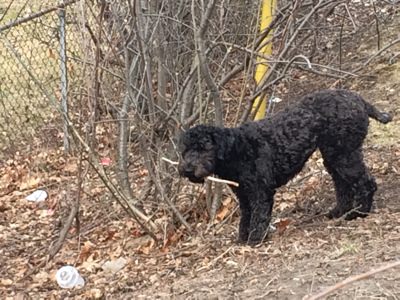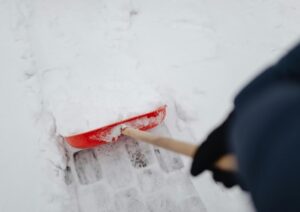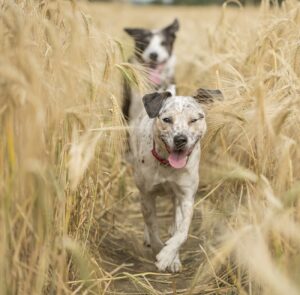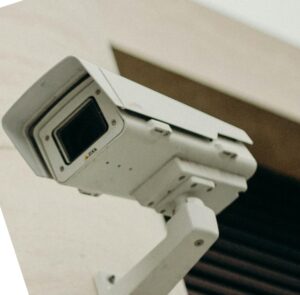Playing games encourages a dog to be inventive, and to deal with the everyday issues that surround him. Through games, dog learns various patterns of behavior, and how to manage complex actions like bringing an item back to you, jumping over a hurdle, or collecting his toys, to get a reward.

When managing enough of games to play with your dog, he grows up into a social being, he gets in contact with humans easy, in a natural and non-aggressive way. He gets to know his weaknesses and strengths. Playing games is also a form of language that dogs use among themselves, to easier overlook differences between them and assimilate with each other, to show dominance or to satisfy their need for physical contacting with others.
Thanks to playing, especially outside, his physical abilities also get developed. Brain and muscles strengthen in a healthy way, and we get one lively puppy, that is wrestling, running, and performing other actions, and happily waiting to get a reward that he deserves. That reward can be a treat, or simply your precious attention! Yes, the value of your approval is very strong, and the rewards should vary from eating a lovely bite, to cuddling and petting, or playing his favorite game, for instance. What can happen is that the dog ignores his favorite treats! Then, he is probably a bit insulted by a lack of your attention. Your dog needs you, above all. Remember that you are his everything.
Games to Play
When it is raining, when the wind is blowing outside, or it is just a lazy Sunday and you decide that you will go out later, and later… Then, it is very useful to have some indoor games in mind, to fulfill your and your pet’s time. Remember, you should never miss a day with him, not only because of the emotions and ethical causes, but because you will pay for that, when your pet suddenly doesn’t respond on your call! So, staying at home can’t be the excuse for being totally inactive. It is only changing the variety of games you will use to fulfill a bit your time. Sometimes, it is fine to be calm and to take a rest, but you will surely see if it is needed, both for you and for your pet. In the meantime, take a look at these fun games to play with your dog, and try to use them to spend more time together and to make that time useful.
Play Hide and Seek
This is one of the structured games. It is a game where you hide from your dog, and he is searching for you. In fact, we all probably remember that we played that game with other kids in the street. The results of this game are mental and physical strengthening, teaching your dog to be calm, even if you disappear for a moment, and giving your dog’s nose the opportunity to prove itself! There are not many ways for them to really trace something when indoor. Here is how you can do it:
Hide and Seek in 3 steps:
- Step 1: You need a friend, a collar and few treats or some nice surprise for your dog. Your friend should hold your dog for his collar, till you disappear in another room, or wherever. If you have a well-trained puppy, you can order your dog to stay, with a simple stay command. Then, you don’t need any helper.
- Step 2: Disappear and call your dog once. He will rush, and you will get found in less than a minute.
- Step 3: Enthusiastically, give him praise, and logically, a treat, before it all loses sense!
Play Tug of War
There is a lot of questioning worldwide, whether this game is good for dogs or it is a bit of working out the aggressive part of dog’s personality. Well, yes, it can’t be done without a certain part of adrenaline, but still, it depends mainly on the owner, how he will lead his dog in this game, and what consequences it will produce. Every single dog on earth feels the personality of his owner. To save the peace and the positive nature of your dog, you should watch out to be the main initiator of the game, as well as you should play this game with your dog only if you can end it whenever you wish, not having problems to calm down your pet. Behave in the way you want him to behave. Our dogs admire us, no matter what we do.
Tug of War in 3 steps:
- Step 1: First of all, make sure you have treats hidden in your pocket. Your dog must be in a calm, sitting “Down” position. The initiative must come from you. One “Get it!” or “Spot!” is usually enough, if the dog is interested in this game. Mainly they all are, but as well as there are different personalities, there are different interests for things. So ask your dog to sit, name the action, and when he gets it…
- Step 2: Here is the main part. Teach your dog to let the tug go: When the game is in the fire, say “Give!” while pushing gently the tug towards. That will not do, but pull out the treat and say it again. You shouldn’t pull the tug anymore, it should be loose. Always keep calm in this phase and never initiate any action. Don’t even cough. In the same second the dog releases the tug, you should praise him and give him that treat. If it took some more time to succeed in this, then you should pay more attention at this step. As a consequence of behaving badly, and not releasing the tug on time, you can make a pause, when you put a tug somewhere between your knees, or else. The dog will give up. Then, put him in that “Down” position again, take the tug and shout “Get it!” , and in that way, you have another way to reward your dog, by bringing him back to the game if he did a good thing, releasing the tug! That can maybe help you to ignore those treats a bit.
- Step 3: Prevent injuries, and keep the game inside the limits of safeness. Don’t ever allow your dog to bite your hand. That would be best if the game was really over when you feel teeth on your skin. This physical contact should never be permitted if the dog is excited.
2 important things to remember about the consequences of behaving badly:
- Disapproval 1: 30 second time out is the way to give a warning to your dog. Don’t smile while doing that. Show your disapproval. This should be done when the dog makes mistakes, doesn’t want to give you tug, or lets his teeth come close to you, or when he grabs the tug without your call on action.
- Disapproval 2: Ending the game – if the same mistake happens three times in a row.
You know your dog best. If he is prone to overreacting, and his mouthing exceeds the point of well behavior, then keep this game a bit in a lower manner. If your dog is so fond of this game, you should make endings like a consequence of overreacting. He will soon learn good manners. The main purpose of this game, besides fun for both you and your dog, is to implement a fact of self control in your dog’s everyday behavior.
Play Fetch
This game leads to relaxing, and making your dog feel tired and satisfied with playing outside, and not to mention the development of his muscles and brain, as well as breathing fresh air. This is a great enjoyment. We all know it is about throwing the ball, and your dogs picks it up and brings it to you after that. However, to some dogs, it will take more time to learn this game. Don’t worry, as soon as they realize what there is to do, they will do it and will never forget it. If they are healthy and well fed, they rush to play this way. With one word, this is a great game!
Fetch in 3 steps:
- Step 1: It is very likely that the dog won’t get the point at once. You should use your tug, for the first few times or maybe days, if he likes the tug game. That way, your dog will think that if he gets it to you, then you will maybe play tug war with him! On the other hand, there is a way to accuse this as an idea, because when we play tug, we don’t want our dog to grab it first, and surely don’t want him to run around with it! Some do it this way, others like it different. Yes, dogs are capable for accommodating in various situations with that same item. If you act fine, that doesn’t matter if you have thrown the tug. Your dog will bring it (or he simply won’t) and will wait for you to call him to an action. You should use the word “give” here, and reward him with a bit of playing tug in this case. The first throw shouldn’t be far. The beginning should be about few inches.
- Step 2: After you’ve thrown the item, you can expect the reaction of wandering around with it, or grabbing it and releasing it in the grass, as well as grabbing it and starring to you. The third is the best for the beginning, but whatever happens in this phase, you should say “Bring!”, because it is a command for this part of the activity. Try to gain the dog to you. When you once start receiving the item from your excited dog and throwing it over again, then you are ready for the last drill.
- Step 3: To make the expressions more precisely defined, this is what you should do: Grab the collar of your dog, and throw the item, let’s say a ball, for example. Then, you encourage him with words “Will you get it?” “Do you want that ball?”, and then when you are letting him go, you say “Get it!” That will, in some time, increase the significance of these words. However, the main part is to get the ball back.
Play Food Bowl Game
This is an exercise more than it’s a game, but it is certain that you will love the benefits of it, and work out some of the positive relations with your dog.
If your dog shows the elements of aggression when you want to touch his bowl with food, you need to work on developing his social behavior. He should know how to share. He was born with the sense of guarding his resources, but he must adopt sharing abilities. This is one of the options to achieve that. It is an easy way to work on your dog’s self control, because the greatest motivation is exactly that bowl with food. Check this out:
Food Bowl in 3 steps:
- Step 1: Hold the bowl up in your hand, and ask your dog to sit. When he sits, start to lower the bowl slowly. He will get up. When that happens, slightly stop lowering the bowl, and raise it up again. When he sits down again, you start to lower it again. At this point, your dog could get a treat if he sits, to notice the moment that brought your approval. But look out for that, you don’t want to make a game out of this part with the treat! If the dog starts using that, then give him no more treats!
- Step 2: By sixth time you should see the progress. Once the bowl is on the floor, you can release your dog and tell him to eat by “Get it” or any other word you choose to be used in this purpose. This should be the easiest accomplished step of all.
- Step 3: Extend the time of keeping your dog calm and sitting, till you can come to the door. Then say the command that means that he can start eating.
What follows is that you can practice to take the bowl with food from your dog. It is a serious step that you can make after this first lesson is done. You come to your dog, and slowly take the bowl. If you can’t do it, because he is threatening you, then use more food for this trick: Try to show, in some way, that you want to add the food in the bowl. Now, try to take the bowl again, but when you take it away, don’t hesitate to put the food into the bowl! Then do as we said, get it down and release the dog. Do it few times. It will give results soon.
3 Very Useful Commands
These are three of about six basic commands that should be taught every dog. These words, when used efficiently, make our life with our dogs easier. They help us teach them other things like games, tricks, and more complicated commands. As always, the beginning is the hardest part. When you fight down these three, you will find it easy to do the rest.
- 1.Sit!
At first, you should catch a moment when your dog sits down. Then, you pay special attention at that, and reward it by giving a treat. Then, you should say “Sit!” every time you notice that he is going to sit. Be patient, and try the command from time to time. If you are persistent in this, it will succeed.
- 2.Stay!
Make him sit. Reward that. Then, include the command “Stay!” by saying it while he is in the sitting position. Count six seconds, and then say “Release!” If that was successful, then start with ten seconds of staying, and it will lead naturally to several minutes, depending on your dog’s readiness and how much he likes to obey. Don’t forget the treats!
- 3.Hush!
Stare at your dog while he is barking. If he stops barking, and turns to you, then reward him. Next time, add the command to the action of rewarding. Besides the verbal command, you can place a motion of your hand into this, and make it work, as well. However, you must be patient with this, also.
5 Tricks for Dogs
There is much beyond the basic tricks and commands that your dog should know, because of his safety and well behavior. Here are some unusual activities that are simple and, at the same time, interesting enough for making us satisfied, and making our dog feel good.
If you’re done with the commands like “Sit!”, “Lie!”, “Come!” and “Stay!”, and you roll over well, then your dog will need just a bit of your patience, and whatever you can think of, you can teach him to do it!
Jump through a Hoop
- Let your dog get to know the hoop, and to feel rewarded when approaching to it. Feel free to give him a treat, few times.
- Call your dog to walk through the hoop, while you are slightly holding it above the ground. If you are using a clicker, click, but also give a treat as a reward while practicing this step
- Now, hold the hoop higher, and try to lead him to jump through it. As usual, he will hope to get some treats, so in these first few classes, you should give him what he deserved.
Leap
Your dog needs to know how to come on command and to stay on command, to get this trick accomplished.
- Put a stick on the floor, and tell your dog to stay. Cross over to the other side of the stick, and call the dog. When he crosses the stick, praise him by clicking and giving him a treat.
- Now, lift the stick a bit higher, but not demandingly high. Place two books on the sides, under the stick. Repeat the procedure from the first step.
- Once when he is custom with all of that, you can implement the command “Leap!” before the moment of clicking and treating. Be persistent in this detail.
Finding Items
Your dog needs to know how to sit, and to know the name of the object.
- Your dog should sit. Hold the item, and let him smell it.
- Hide the item in the way that he can see what you’re doing. Call him to action, by saying “Find it!” and give the approval when he touches the item. Repeat this step several times.
- Let him smell the other item, and give the same command, to see if there is success.
Park
This one is not a trick or a game, but it is very useful, though not so funny…
- When you go for a walk, and you see that he’s done with his “business”, click the clicker and give your dog a treat.
- Implement verbal command “Park” or any other that you determine to be.
- Be sure to reward this activity each time, by a treat, or by a long walk, or playing fetch, etc.
Play Dead
- Guide your dog gently into “play dead” position. That is the position of lying down, with his legs in the air, with his paws bent, and with no movement. Encourage him by clicking and giving him treats.
- Repeat the process few times.
- Try him on your voice command only, and if it was successful, start only clicking, to avoid giving him treats every time.
What Makes you so Important?
Dogs that often play with their owners differ in some way from other dogs. They will not wrestle with you or any other human. They will only wrestle with other dogs. They are more socialized. They feel loved, and they are able to act calm, while the dogs that don’t usually experience these games with the humans have the need to run away in some way, or to wander off with other dogs. Dogs simply feel whether the presence of their owner is complete or it isn’t. You don’t need to act as a dog, or behave silly, to make your dog feel good, even if your dog is still a puppy. You can just remember that you are the owner, the only person that is responsible for that puppy’s health and well-being. Therefore, you should follow some well worked-out patterns, as well as you should follow you own instincts, and think of some time to spend it together with your pet.





Be First to Comment